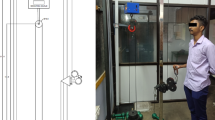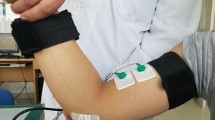Abstract
The assessment of muscular interactions between biceps, triceps, and brachioradialis can be used as an approach for the detection of spasticity in the upper limbs. A crucial prerequisite for the aforementioned validation of muscular interactions is the calculation of time frequencies due to the non-stationary characteristics of electromyographic (EMG) signals and thus the estimation of coherences. Adding biomechanical parameters increases the validity of the assessment process and simplifies the comparison of EMG data as a result of categorization. In this numerical-experimental study, a method will be introduced by using the smoothed pseudo Wigner-Ville distribution and a categorization algorithm to estimate and categorize coherences between biceps, triceps, and brachioradialis during dynamic contractions. The categorization will be performed according to the type of contraction, external load, joint angle, and angular velocity and will be used to assess 10 healthy subjects and 6 patients with spasticity. Generally, the introduced method shows the velocity dependence of coherence during spasticity in extension movements as well as much stronger muscular co-activation between triceps, biceps, and brachioradialis in spastic patients in comparison to healthy subjects. Furthermore, the influence of variables e.g. as joint angle, angular velocities, and type of contraction on the coherence is quantified.





Similar content being viewed by others
References
Alarcon F, Zijlmans JC, Duenas G, Cevallos N (2004) Post-stroke movement disorders: report of 56 patients. J Neurol Neurosurg Psychiatry 75(11):1568–1574
Bohannon RW, Smith MB (1987) Interrater reliability of a modified Ashworth scale of muscle spasticity. Phys Ther 67(2):206–207
Bonato P, Roy SH, Knaflitz M, de Luca CJ (2001) Time-frequency parameters of the surface myoelectric signal for assessing muscle fatigue during cyclic dynamic contractions. IEEE Trans Biomed Eng 48(7):745–753
Buchthal F, Clemmesen S (1946) Action potentials in pathological postural reflex activity (spasticity and rigidity). Acta Psychiatr Scand 21(1–3):151–175
Cohen L (1966) Generalized phase-space distribution functions. J Math Phys 7(5):781–786
Costa AH, Boudreau-Bartels GF (1995) Design of time-frequency representations using a multiform, tiltable exponential kernel. IEEE Trans Signal Process 43(10):2283–2301
Fang Y, Daly JJ, Sun J, Hvorat K, Fredrickson E, Pundik S, Sahgal V, Yue GH (2009) Functional corticomuscular connection during reaching is weakened following stroke. Clin Neurophysiol 120(5):994–1002. https://doi.org/10.1016/j.clinph.2009.02.173
Fellows SJ, Kaus C, Ross HF, Thilmann AF (1994) Agonist and antagonist EMG activation during isometric torque development at the elbow in spastic hemiparesis. Electroencephalogr Clin Neurophysiol 93(2):106–112
Guerrero-Mosquera C, Trigueros AM, Franco JI, Navia-Vázquez Á (2010) New feature extraction approach for epileptic EEG signal detection using time-frequency distributions. Med Biol Eng Comput 48(4):321–330
Hermens HJ, Freriks B, Disselhorst-Klug C, Rau G (2000) Development of recommendations for SEMG sensors and sensor placement procedures. J Electromyogr Kinesiol 10(5):361–374
Hsiao DNS-F (2001) Knee muscle isometric strength, voluntary activation and antagonist co-contraction in the first six months after stroke. Disabil Rehabil 23(9):379–386
Husar P (2010) Biosignalverarbeitung. Springer-Verlag, Berlin
Kisiel-Sajewicz K, Fang Y, Hrovat K, Yue GH, Siemionow V, Sun C-K, Jaskólska A, Jaskólski A, Sahgal V, Daly JJ (2011) Weakening of synergist muscle coupling during reaching movement in stroke patients. Neurorehabil Neural Repair 25(4):359–368
Komi PV, Linnamo V, Silventoinen P, Sillanpää M (2000) Force and EMG power spectrum during eccentric and concentric actions. Med Sci Sports Exerc 32(10):1757–1762
Lance JW (1980) Symposium synopsis. In: Feldmann RG, Young RR, Koella WP (eds) Spasticity: disordered motor control. Year Book Medical Publishers, Chicago Google Scholar, Chicago
Linnamo V, Bottas R, Komi PV (2000) Force and EMG power spectrum during and after eccentric and concentric fatigue. J Electromyogr Kinesiol 10(5):293–300
Linnamo V, Moritani T, Nicol C, Komi PV (2003) Motor unit activation patterns during isometric, concentric and eccentric actions at different force levels. J Electromyogr Kinesiol 13(1):93–101
Matz G, Hlawatsch F (2000) Time-frequency coherence analysis of nonstationary random processes. In: Statistical signal and Array processing, 2000. Proceedings of the tenth IEEE workshop on, pp 554–558
Mehrholz J, Wagner K, Meißner D, Grundmann K, Zange C, Koch R, Pohl M (2005) Reliability of the modified Tardieu scale and the modified Ashworth scale in adult patients with severe brain injury: a comparison study. Clin Rehabil 19(7):751–759
Meste O, Rix H, Caminal P, Thakor NV (1994) Ventricular late potentials characterization in time-frequency domain by means of a wavelet transform. IEEE Trans Biomed Eng 41(7):625–634
Nakazawa K, Kawakami Y, Fukunaga T, Yano H, Miyashita M (1993) Differences in activation patterns in elbow flexor muscles during isometric, concentric and eccentric contractions. Eur J Appl Physiol Occup Physiol 66(3):214–220
Orini M, Bailón R, Mainardi LT, Laguna P, Flandrin P (2012) Characterization of dynamic interactions between cardiovascular signals by time-frequency coherence. IEEE Trans Biomed Eng 59(3):663–673
Patrick E, Ada L (2006) The Tardieu scale differentiates contracture from spasticity whereas the Ashworth scale is confounded by it. Clin Rehabil 20(2):173–182
Praagman M, Chadwick EK, van der Helm FC, Veeger HE (2010) The effect of elbow angle and external moment on load sharing of elbow muscles. J Electromyogr Kinesiol 20(5):912–922
Sahrmann SA, Norton BJ (1977) The relationship of voluntary movement of spasticity in the upper motor neuron syndrome. Ann Neurol 2(6):460–465
Thilmann AF, Fellows SJ, Garms E (1991) The mechanism of spastic muscle hypertonus. Brain 114(1):233–244
von Werder SC, Kleiber T, Disselhorst-Klug C (2015) A method for a categorized and probabilistic analysis of the surface electromyogram in dynamic contractions. Front Physiol 6
von Werder SCFA, Disselhorst-Klug C (2016) The role of biceps brachii and brachioradialis for the control of elbow flexion and extension movements. J Electromyogr Kinesiol 28:67–75
White LB, Boashash B (1990) Cross spectral analysis of nonstationary processes. IEEE Trans Inf Theory 36(4):830–835
Williams S, Schmidt R, Disselhorst-Klug C, Rau G (2006) An upper body model for the kinematical analysis of the joint chain of the human arm. J Biomech 39(13):2419–2429
Yan Y-S, Poon CCY, Zhang Y-T (2005) Reduction of motion artifact in pulse oximetry by smoothed pseudo Wigner-Ville distribution. J Neuroeng Rehabil 2(1):1
Zhan Y, Halliday D, Jiang P, Liu X, Feng J (2006) Detecting time-dependent coherence between non-stationary electrophysiological signals—a combined statistical and time-frequency approach. J Neurosci Methods 156(1):322–332
Funding
The authors were financially supported for parts of the work by the Federal Ministry of Education and Research (BMBF) of Germany within the framework of inRehaRob.
Author information
Authors and Affiliations
Corresponding author
Ethics declarations
Conflict of interest
The authors declare that they have no conflict of interest.
Ethical approval
All procedures performed in studies involving human participants were in accordance with the ethical standards of the institutional and/or national research committee and with the 1964 Helsinki declaration and its later amendments or comparable ethical standards.
Informed consent
Informed consent was obtained from all individual participants including in this study.
Rights and permissions
About this article
Cite this article
Becker, S., von Werder, S.C.F.A., Lassek, AK. et al. Time-frequency coherence of categorized sEMG data during dynamic contractions of biceps, triceps, and brachioradialis as an approach for spasticity detection. Med Biol Eng Comput 57, 703–713 (2019). https://doi.org/10.1007/s11517-018-1911-3
Received:
Accepted:
Published:
Issue Date:
DOI: https://doi.org/10.1007/s11517-018-1911-3




